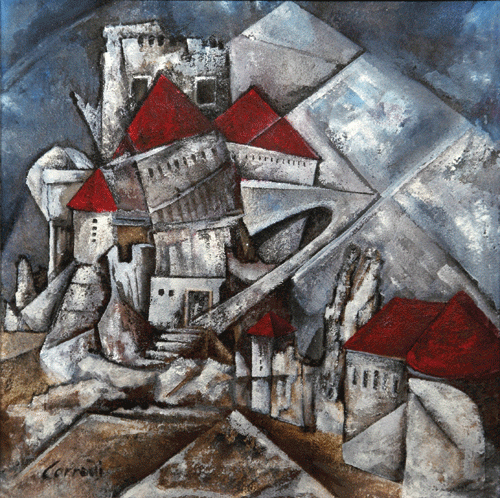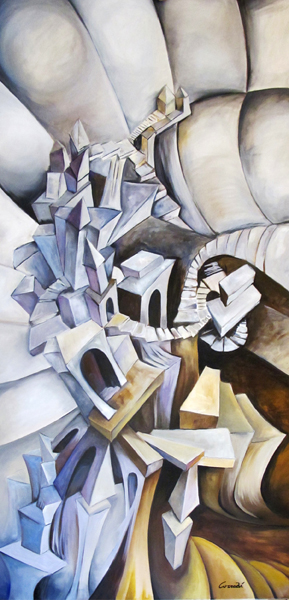Atlanta, GA. Italo Calvino’s 1972 book Invisible Cities is pitched somewhere between novel and poetry. It consists of 55 short descriptions of imaginary cities, arranged with complex mathematical precision and connected by a frame narrative that depicts Marco Polo describing them to Kublai Khan. Thus there is no real “plot” to the book. Neither can we take the descriptions of the cities as realistic, blending as they do 13th– and 20th-century technologies with fanciful elements. As Calvino notes in the opening narration, “Kublai Khan does not necessarily believe everything Marco Polo says when he describes the cities visited on his expeditions, but the emperor of the Tartars does continue listening to the young Venetian with greater attention and curiosity than he shows any other messenger or explorer of his” (5). And who could blame him? Polo’s tales, as Calvino invents and conveys them, are spellbinding, and, in the great postmodern fabulist tradition that Calvino represents alongside writers like Jorge Luis Borges and Robert Coover, the obvious artifice and fantasy of the descriptions give us permission to ignore the question of falsehood altogether and experience them as the weird, tight little metaphysical fables that they are.
I hesitate to use the word fable, suggesting as it does something with a clear moral lesson—because the truth is that, while Calvino certainly has some wisdom to impart to his world and ours, he does so primarily through striking and unforgettable images: the cycling identities of the residents of Eutropia, who switch cities and social roles whenever they get bored; the identical buildings of Zoe, which conceal the huge variety of human existence beneath their indistinguishable façades; and the physicalized Platonism of Isaura, whose visible form limns the shape of a subterranean lake, the reflection of which inspires two contradictory religions. I have picked three examples literally at random, but they ought to make Calvino’s method clear: these cities are not exactly allegories for 20th-century European politics, nor are they parables with a clear moral lesson to impart. Instead, let’s call them by the etymologically related term parabolas, symmetrical horseshoes that are consistently related to their locus even as they move further and further away from it. That locus is the single real city mentioned in the book, Polo’s hometown of Venice. He never describes it directly, but as he tells Kublai, “Every time I describe a city I am saying something about Venice” (86). We see our own world in the brilliant facets of Calvino’s crystallized imagination—see it not through metaphor but through pataphor, that hypothetical figure of speech in which the right side of the metaphor becomes the left side of another metaphor, the “meaning” of which dances just beyond our vision.
And yet, as I have said, there is real wisdom in the strange little descriptions of these made-up cities, and we can use them (if that crude and utilitarian term is not too vulgar) to understand tendencies in the human soul that are eternal even if I hesitate to call them universal. Every society from now until the end of human civilization will, I suspect, be able to see itself in the pataphysical shards of Invisible Cities—the difference will be in which fragments reflect the changing light of the times most strikingly. When I read the book recently, it was Leonia—presented under the heading “Continuous Cities 1”—that glinted the brightest. In it, I see a distorted reflection of Western society circa 2021, chasing fast on the heels of the future but unable to escape the past that is never not in pursuit of it.
Leonia, Marco Polo tells Kublai Khan, “refashions itself every day: every morning the people wake between fresh sheets, wash with just-unwrapped cakes of soap, wear brand-new clothing, take from the latest model refrigerator still unopened tins, listening to the last-minute jingles from the most up-to-date radio” (114). He is describing a world defined by the relentless pursuit of novelty, especially in the realm of consumer products. As such, he is taking modern Western consumer capitalism to its absurd conclusions. In our world, people line up outside the Apple Store for the privilege of replacing their still-functioning phone with the latest model, and we feed ourselves with processed foods whose paper and plastic wrappers contribute heavily to the more than 290 million tons of packaging waste every year in the U.S. alone. The cycle in Leonia is sped-up, with new appliances appearing every day.
One helpful way to describe the Leonians is to say that they are curious. The word mostly has a positive meaning in contemporary usage, but there’s a long history of seeing curiosity as a vice. St. Augustine, for example, distinguishes between curiositas and the more virtuous studiositas, connecting the former to St. John’s condemnation of “the desire of the flesh, the desire of the eyes, the pride in riches” (1 Jn 2:16, NRSV). It is worse, he says, than the mere desire for pleasure:
Pleasure pursues beautiful objects—what is agreeable to look at, to hear, to smell, to taste, to touch. But curiosity pursues the contraries of these delights with the motive of seeing what the experiences are like, not with a wish to undergo discomfort, but out of a lust for experimenting and knowing. What pleasure is to be found in looking at a mangled corpse, an experience which evokes revulsion? Yet wherever one is lying, people crowd around to be made sad and turn pale. (Confessions 10.35.55)
Curiosity is thus interested less in understanding than in seeking and experiencing novelty. For this reason, Martin Heidegger—whom I often think of as a kind of semi-secularized Augustine—classes it among the habits that cut human beings off from the true contemplation and understanding of Being. Curiosity, he writes, “concerns itself with seeing, not in order to understand what is seen, . . . but just in order to see. It seeks novelty only in order to leap from it anew to another novelty” (Being and Time 172). Both Augustine and Heidegger are talking specifically about intellectual curiosity, but Heidegger in particular is applicable to the variety found in Leonia, writing, as he does in 1927, right on the cusp of the explosion of consumerism in the middle of the 20th century. In pushing for their material conditions to be updated every evening, Leonians are demanding a kind of endlessly renovating novelty, with the result that they hardly exist in the world at all. Instead, they live day to day looking forward—not to their deaths, the central fact that Heidegger wants us always to be aware of—but to the next morning’s novelties. They—we—are children opening presents on Christmas morning, scarcely noticing each one before moving on to the next. In curiosity, Heidegger writes, “Dasein”—that mode of Being that belongs to humans—“is constantly uprooting itself” (173). Pope Francis is getting at something similar with his memorable phrase “throwaway culture”; a culture that endlessly renews itself is a culture that endlessly discards old selves and their material and spiritual detritus.
Notice, too, the way these products appear magically in the citizens’ homes. It could be that Calvino is merely omitting the step whereby they purchase these items for themselves and bring them home every day, but Polo’s silence on this matter presents the daily renewal as an automatic, almost a magical, process. Calvino, who belonged to the Communist Party for the decade after World War II, would certainly have been aware of the exploitation hidden behind the magic: the workers who create and deliver these products every day are invisible, and their invisibility allows them to be taken advantage of. The COVID-19 pandemic has revealed the extent to which our own society relies on the formerly invisible “essential workers” of grocery stores and pharmacies (and despite the attention they’ve received this year, we’ve done little to change their working conditions for the better). Meanwhile, we have become even more reliant on the underpaid and increasingly dangerous work of Amazon warehouse employees and the “independent contractors” at GrubHub and Uber Eats. If their society is anything like our own, the residents of Leonia sleep while members of its “gig economy”—or the drones that replace them—slip noiselessly into their homes, replace their immediately outdated devices and consumer goods, and slip away again, making billions for the companies that employ them but little more than minimum wage for themselves.
The tech companies that increasingly control our economy take this relentless pursuit of novelty as a core value, in a process commonly called “creative disruption” or “disruptive innovation.” “Move fast and break things,” went the infamous former motto of Facebook, and while it sounds like a warning, it has largely been a recommendation for the current masters of the universe. As Jill Lepore puts it,
Disruptive innovation as an explanation for how change happens is everywhere. Ideas that come from business schools are exceptionally well marketed. Faith in disruption is the best illustration, and the worst case, of a larger historical transformation having to do with secularization, and what happens when the invisible hand replaces the hand of God as explanation and justification. Innovation and disruption are ideas that originated in the arena of business but which have since been applied to arenas whose values and goals are remote from business. (35)
The mantra of creative disruption suggests, overtly or covertly, that all existing human institutions can be improved by being continuously dismantled and reassembled. The problem is that these institutions developed, often organically, over decades, sometimes centuries, and that they belong to and serve complex human ecosystems that will be disrupted and destroyed if their institutions are dismantled. And this is true even if the people leading those institutions are not particularly virtuous.
Take the music industry, for example. Its abuse of artists in its heyday was legendary. An early ‘90s article by producer, engineer, and notorious grump Steve Albini documents the predatory contracts that young artists often signed without even realizing they were contracts and the huge profits taken by A&R men, managers, and lawyers, leaving little for the artists themselves. He gives the example of a band who gets a $250,000 advance, sells three million dollars worth of records, and walks away with about $4,000 apiece. “The band members,” Albini notes, “have each earned 1/3 as much as they would have working at a 7-11, but they got to ride in a tour bus for a month.”
Certainly it’s hard to mourn the death of an industry in which the people at the top get rich by exploiting the artists who made the product being sold. But the music industry was killed not by people seeking the good of the artists but by tech companies practicing their business model of creative disruption. The disruption began with infamous file-sharing services like Napster, which were eventually shut down for not making anyone any money. It was replaced by the current streaming model, which gives a veneer of respectability and justice to file-sharing by asking listeners to pay a monthly subscription fee or listen to advertisements. The model is enormously lucrative—for the streaming services. In 2019, Spotify made almost three billion dollars (though it must be noted that this was not enough to turn a profit; Spotify, like Uber and many other industry-dismantling startups, loses money, hoping to eliminate the competition and then raise their rates). The artists whose music makes up the service, however, make less than half a cent per stream. In 2013, David Lowery, of the bands Camper Van Beethoven and Cracker, revealed that his song “Low” had been played one million times on Pandora, resulting in his receiving a check for a cool $16.89. Streaming services allow the consumer enormous freedom of choice, but they turn musicians into the invisible laborers of Calvino’s Leonia. (It’s true that other disruptions of the music industry, like Bandcamp or Patreon, which allow artists more or less direct access to listeners, are less exploitative, but as of 2019, streaming made up 80 percent of the music industry’s total revenue.)
Lepore rightly points out that disruptive innovation is part of a larger metaphysical outlook:
The idea of progress—the notion that human history is the history of human betterment—dominated the world view of the West between the Enlightenment and the First World War. It had critics from the start, and, in the last century, even people who cherish the idea of progress, and point to improvements like the eradication of contagious diseases and the education of girls, have been hard-pressed to hold on to it while reckoning with two World Wars, the Holocaust and Hiroshima, genocide and global warming. Replacing “progress” with “innovation” skirts the question of whether a novelty is an improvement: the world may not be getting better and better but our devices are getting newer and newer.
Painted with the broadest possible strokes, Western history since the eighteenth century is a project of mass forgetfulness, built on the assumption that what is new is necessarily better than what is old. C.S. Lewis calls this position “chronological snobbery” (Surprised by Joy 207-208); Herbert Butterfield calls it “the whig interpretation of history” and says that it involves a professional or amateur historian’s oversimplification of the past to produce “a bias in favour of the whigs” and against “Catholics and tories” and other representatives of the unpleasant and unvirtuous past (The Whig Interpretation of History 25). The conservative, of course, has his own besetting sins—all too often he evinces a sort of clinging to the past at any cost, a defense of what is simply because it is, no matter how indefensible it might be. But the corrective cannot be the wholesale repudiation of the past for the crime of being different from the present—or, more accurately, from the future we imagine for ourselves, a future in which we will at last be free from the failures and shortcomings that have plagued our race for so many centuries.
Progress, in other words, is real: only a fool would say that the partial dismantling of social structures accomplished by the Civil Rights Movement was unnecessary—or, for that matter, that more work does not need to be done. But I am conservative enough to be skeptical of revolution, of the idea that what lies on the other side of the clear-cutting of history will be better than the imperfect but vital institutions that have been burned to the ground. It would be a terrible exaggeration to say that revolution is the same thing as lining up for the newest iPhone on the day of its release—but the two are closer together than the revolutionary may be inclined to think. Sometimes what we have is past its useable life and must be replaced. More often, however, we’d do better to repair it. And that’s much truer of culture than of technology and consumer goods: let’s make what we have—what is ours and what we are—more equitable and virtuous rather than discarding it for something that may be even worse.
Calvino’s Leonia demonstrates the dangerous dialectic involved in the relentless pursuit of novelty. The irony, as he describes it, is that “the more Leonia expels goods, the more it accumulates them; the scales of the past are soldered into a cuirass that cannot be removed. As the city is renewed each day, it preserves all of itself in its only definitive form” (115). The garbage and detritus of a disposable culture ends up defining that culture, and so the constant radical change of Leonia ends up being a static shape even uglier than the past. And that past doesn’t go away anyway: what is discarded still has a material life that functions as the city’s dangerous shadow self. And somewhere in Leonia’s future is a disaster, manmade but inevitable:
The greater [the pile of garbage’s] height grows, the more the danger of a landslide looms: a tin can, an old tire, an unraveled wine flask, if it rolls toward Leonia, is enough to bring with it an avalanche of unmated shoes, calendars of bygone years, withered flowers, submerging the city in its own past, which it had tried in vain to reject, mingling with the past of the neighboring cities, finally clean. A cataclysm will flatten the metropolis always dressed in new clothes. (115-116)
I think here of the entirely reasonable movement to remove the Confederate flag from public buildings, to rename forts named after Confederate generals, and to take their statues off public land. But burying the past won’t make the vices that animated it magically disappear. We’d do better, I think, to follow the lead of Budapest’s Memento Park, which features 42 statues constructed during the communist era, neither glorified nor forgotten. “That’s our history,” the docent of a small-town opera house once told me about a Confederate flag painted in the corner, which a group of Black musicians asked to be covered during their performance. She was right, but history is neither innocent nor absolutely guilty, and given the history of the usage of that flag since Reconstruction, I don’t think it’s wise to fly it. But that position is a long way from the sort of mass destruction we saw after the George Floyd protests, when statues were torn down not because they depicted traitors to the country or served as metonyms for hate groups, but because the people memorialized—from George Washington to Junipero Serra—held views or did things that we now recognize as wrong, however much good they may have done. (And I don’t trust an angry mob to do anything.) The apotheosis is doubtless the San Francisco school board’s decision to scrub Abraham Lincoln’s name from a school. Lincoln’s history with race is not unimpeachable, but his being lumped in with Jefferson Davis and Robert E. Lee has an absurdist humor to it, tempered only by its tragic irony. The country that tries to be always new is doomed to be submerged by its discarded past.
The dump outside Leonia continues to fill up, with working devices next to rusting husks of machines and rotting garbage, but our society will be defined by what we reject as much as, or more than, by what we celebrate. History is more dangerous when we bury it than when we acknowledge it and, ideally, seek to renovate it—and in our fraught times, who could deny that we are the beat of a bird’s wing away from having it collapse and bury our poor guilty and benighted country once and for all? The solution, I think, is a kind of conservationism—as distinguished from movement conservatism, which in its contemporary American form is as unthinkingly destructive as any revolutionary could hope to be. The conservationist, on the other hand, recognizes that the good things we have cannot be easily replaced, and so she holds onto them, cleaning and repairing them when necessary, keeping the health of the ecosystem in mind when she discards what needs to be discarded. Conservationism, unlike movement conservatism and revolutionism, requires us to be virtuous, requires us to be flexible and thrifty and pious toward the institutions and structures that sustain us even as we recognize their flaws and imperfections and try to remedy them. The conservationist recognizes that the society we live in, as much as the natural world we live in, was given to us as a gift with the demand that we pass it on to future generations, and therefore it is neither easily discarded nor above reproach.
All paintings are from Colleen Corradi Brannigan’s series on Invisible Cities and are used by permission. See her website for more information.







